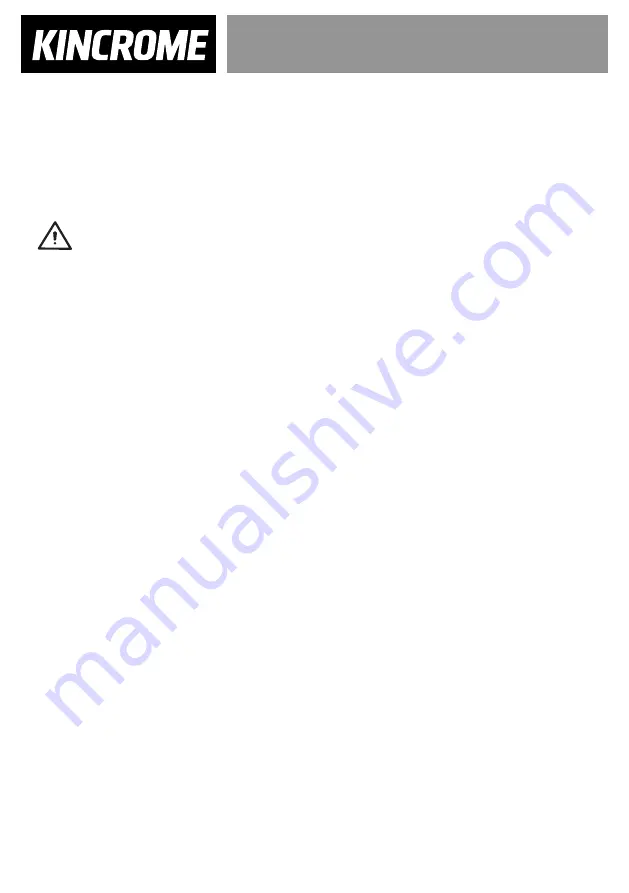
7
PRESSURE SPRAYER
1.5 LITRE
Field of Application
Range of sprayers equipped with the highest performance in terms of safety and ease of use. Designed to provide greater
durability and versatility for professional use against the most aggressive chemicals in various sectors (cleaning and
disinfection, construction, automotive and industrial warehouses and workshops, etc.). Particularly acid-resistant. Given
the great variety of products in the market, Kincrome cannot guarantee the universal validity of its equipment. In any case,
we recommend using certified chemicals.
Setting up & Spraying
You must be in good physical condition and mental health and not under the influence of any substance (drugs, alcohol,
etc.) which might impair vision, dexterity or judgment. Do not operate this handheld sprayer when you are fatigued.
Always inspect your sprayer before and after each use. To reduce the risk of leakage and skin contact with chemicals,
check that the cap is tight, and in good condition before pressurizing the container.
1. Stand the tank on a level surface
2. Unscrew the sprayer head by turning it anticlockwise (Figure 2.1a).
3. Fill up with thoroughly mixed plant protection/cleaning product. Do not exceed maximum capacity of the indicated
maximum for the pressure sprayer Figure 2.1b).
4. Screw tightly to close.
5. Pressurise the device by pumping plunger trigger (approx. 15-20 times) (Figure 2.2).
6. To begin spraying, make sure the safety lock is off (Figure 2.3).
7. Press the handle and, as you work, compensate for the loss in pressure by making more passes.
8. Once the work is finished, activate the safety lock (Figure 2.4a) and release the pressure by pulling the safety valve (Figure 2.4b).
9. If more than one appliance is used with different chemicals, use the identification marker to identify the contents of each
appliance by placing it on the end of the handle (Figure 2.5a). To remove it, pull it in the direction shown by the arrows (Figure
2.5b) using a tool or pointed instrument (Figure 2.5c).
After Finishing Work
Always release the pressure out of the container after finishing work. To release the pressure, turn the knurled wheel on the
pressure relief valve while holding the unit upright until there is no more air or mist coming out. Open the cover slowly to make
sure that the container is completely de-pressurized. Avoid breathing in the mist which is released. Always wash thoroughly with
soap and water after spraying or handling chemicals. Shower immediately, and wash all protective clothing separately. Follow any
additional recommendations of the chemical manufacturer. Always clean dust and dirt off the sprayer.
Maintenance
K16020
1. After each use, de-pressurise the sprayer (Figure 3.1).
2. Collect and dispose of the residual amount of chemical according to the legislation, prescriptions, and
applicable regulations.
3. Clean the appliance with water.
4. In the event of obstruction of the nozzle, clean it with water and do not use metallic objects (Figure 3.2).
5. In order to prolong the life of the joints, regularly apply some drops of oil or grease on the moving parts (Figure 3.3).
6. To access the valve chamber, remove the cylinder guard by pulling it firmly (Figure 3.4).
7. To access the rod’s O-ring, unscrew the piston and remove it until leaving visible the aforementioned
O-ring (Figure 3.5).
8. Store the sprayer indoors protected from frost and extreme heat (between 5ºC and 30ºC (40ºF & 85ºF)) (Figure 3.7).
K16021
1. After each use, de-pressurise the sprayer (Figure 3.1).
2. Collect and dispose of the residual amount according to the legislation, prescriptions, and applicable regulations.
3. Clean the appliance with water.
4. In the event of obstruction of the nozzle, clean it with water and do not use metallic objects (Figure 3.2).
5. In order to prolong the life of the joints, regularly apply some drops of oil or grease on the moving parts (Figure 3.3).
6. To access the valve chamber, remove the cylinder guard by pulling it firmly (Figure 3.4).
7. To access the rod’s O-ring, unscrew the piston and remove it until leaving visible the aforementioned O-ring (Figure 3.5).
8. The apparatus has a felt pad installed in front of the nozzle (Figure 3.6a). This filter is to be cleaned with water when it|
is dirty. If it is completely damaged or is extremely dirty, replace it with a spare part. In the device there is a strip
with 10 supplementary filters (Figure 3.6b). Remove the used filter using a pointed object. (Figure 3.6c).
9. Store the sprayer indoors protected from frost and extreme heat (between 5ºC and 30ºC (40ºF & 85ºF)) (Figure 3.7).




























